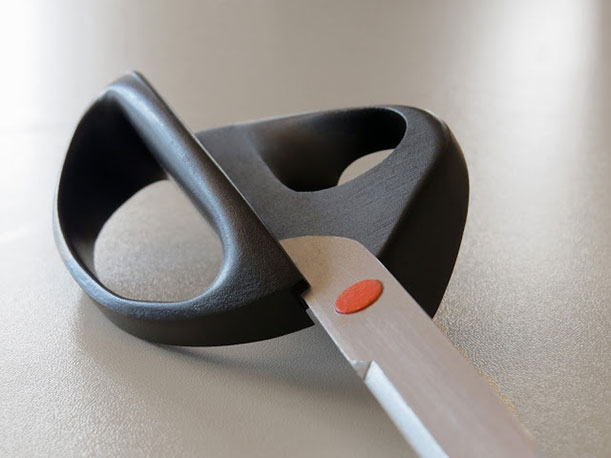Scissors That Cut Perfectly Straight Lines—Every Time!
An industrial design major has made it possible to make precise cuts without rulers or a heavy-duty guillotine
/https://tf-cmsv2-smithsonianmag-media.s3.amazonaws.com/filer/20131108123116vector-scissors-web.jpg)
Despite it’s all-around usefulness, it’s a wonder why scissors can’t even cut straight. For a fairly, um, straightforward task, you’d have to fiddle with a ruler to outline precise measurements or go heavy-duty and get a paper cutter, otherwise known in craft circles as the guillotine.
Hungarian designer Tamás Fekete doesn’t have that problem. He used to. But that was until a homework assignment for a class at the Moholy-Nagy University of Art and Design in Budapest gave the first-year industrial design student an opportunity to take on a challenging issue that surprisingly has been neglected for thousands of years. After six months of prototyping, his invention, the Vector scissors, has come to demonstrate how applying a different approach to how scissors ergonomically work produces a beautifully minimalist solution to the longstanding problem.
“At the very beginning I realized that for a straight cut I needed to use other tools such as a paper guillotine, a cutting knife or a ruler,” he told Wired. “I asked myself, ‘Are these really the only ways for a straight cut?’”
Although scissors have undergone numerous makeovers over the years, the tool’s basic functionality hasn’t changed all that much. Most modifications can be considered nothing more than customized tweaks, done primarily as a way to turn a standard pair of criss-crossing blades into specialized tools better suited for certain professions. There’s, for instance, hair-cutting scissors, fabric-cutting shears for tailors and specialty kitchen sets. There’s even left-handed and right-handed scissors. I guess you can say the evolution of scissors has developed in more of a splintered direction, rather than a linear progression.
The principle innovation underlying Fekete’s straight-cutting Vector scissors, however, addresses a dilemma common to many scissor-necessitating crafts, whether it’s dealing with paper, fabrics or a variety of other materials. Being that any form of purely hand-guided cutting is already inherently error prone, Fekete started by looking at ways to redesign the device so that users can take advantage of the straight edges that form the surface of a square or rectangular table. The best approach, he discovered, was to re-shape the left handle so that it can rest flat atop the table, while the right handle follows the table’s edge, positioning the blades at a steady 90 degree angle. As the user cuts forward, this left handle, built thicker and wider, also works to direct paper away from the user’s fingers to prevent accidental papercuts. And to keep the blades from scratching the table, he rounded the edges where they would touch. (Unfortunately, there isn’t a version for lefties.)
The simplicity of merely rethinking how a tool is ergonomically conceived is a sharp example of how design-based solutions often triumph over whatever sophisticated technology has thrown at a problem. Currently, the only aggressively-marketed option that helps users cut in a straight line is a pair of scissors that features a mounted laser to steer the cutting action forth. Reviews from those who have used it seem to indicate that the product hasn’t exactly been a hit with the masses. And I mean really? Do we need a potential child safety hazard comprised of complicated mechanical parts, which also poses greater risk for breaking and malfunction, just to cut a straight line?
Fekete hasn’t publicly stated how he plans to bring Vector scissors to the the mass market, and, as a foreigner, he isn’t allowed to launch a Kickstarter campaign just by himself. For now, there’s only an official website that let’s people anxiously awaiting to wrap their fingers around one to sign up for future updates.
/https://tf-cmsv2-smithsonianmag-media.s3.amazonaws.com/accounts/headshot/tuan-nguyen.jpg)


/https://tf-cmsv2-smithsonianmag-media.s3.amazonaws.com/accounts/headshot/tuan-nguyen.jpg)